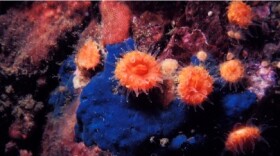State wildlife officials are requesting more than $8.5 million in emergency funding from the Legislature to boost the fight against invasive European green crabs. A new tool might make that more effective: environmental DNA.
New research from scientists at the University of Washington and Washington Sea Grant confirms that eDNA works as well as physical trapping to detect the crabs' presence.
The small green crabs are voracious eaters that can easily outcompete native species, crush bivalves and lay waste to critical habitat, with effects that reverberate up the food chain.
“The trickle-down effect that they can have in our marine ecosystems, whether it's digging up clams or decimating eelgrass beds, can have a serious impact on species from chinook salmon to resident killer whales to native shellfish and crab species,” says Chase Gunnell, a spokesman with the state Department of Fish and Wildlife.
“It’s really something that we need to get ahead of, and we need to increase the scale of our response.”
On the East Coast, where they first arrived in the early 1800s, they’ve dramatically reduced the harvest of important shellfish species, such as soft-shell clams in Maine.
Gunnell says last year’s record heat allowed populations to spike in the Lummi Nation’s Sea Pond and in several areas of Washington’s outer coast.
There's major concern now that the crabs could spread south into Puget Sound. Testing for their genetic material in the environment could catch any expansion early.

“The ability to use DNA tools to help monitor and potentially prevent that is a major tool in our toolkit,” Gunnell says.
A new paper confirms that analyzing environmental DNA is just as effective as physical trapping for identifying where green crabs are present.
Right now, eradication efforts depend mostly on baited traps to remove and contain the invaders; pesticides are not an option in the delicate habitats they threaten.
Emily Grason is a marine ecologist and the program lead of the Crab Team at Washington Sea Grant, which has been working to contain the invaders since 2015.
She says a lot of people wish for a silver bullet to replace "boots in the mud" in this fight. And eDNA won’t do that, but she says this new research shows that it can be equally effective in identifying where green crabs are present — and deciding where to intensify trapping efforts.
“For those tools that we do have — we have to trap really smart. It is hard work, and it takes a lot of human power to do the trapping. We need information in order to trap smart,” Grayson says.
“And this is something that gives us more confidence that we could deploy our resources in a cost-effective way.”

In January, Gov. Jay Inslee issued an emergency proclamation after the Lummi Tribe trapped more than 70,000 of the invasive species in its Sea Pond. Growing populations on the outer coast also remain an ongoing concern.
Budget negotiations in the coming weeks will determine how much of the governor’s request for emergency funding will be granted by the Legislature to ramp up trapping and containment.







